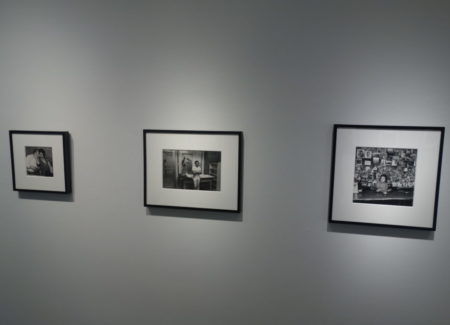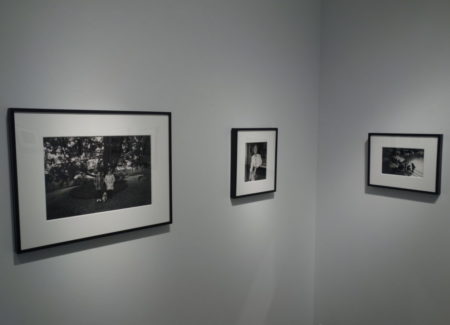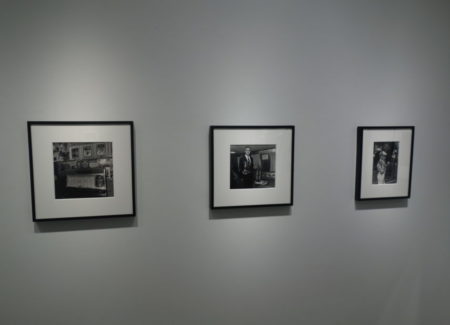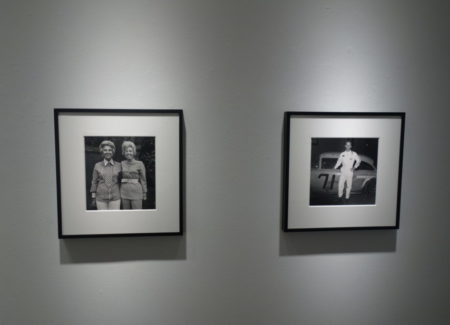JTF (just the facts): A total of 21 black and white photographs, framed in black and matted, and hung against white walls in the main gallery space. All of the works are vintage gelatin silver prints, made between 1970 and 1977. Physical sizes range from 7×9 to 16×20 (or reverse). A monograph of this body of work was recently published by Honky Tonk Editions (here). (Installation shots below.)
Comments/Context: Henry Horenstein’s photographs from the 1970’s celebrate the subtle quirkiness of American life. The eccentricities and marginalia found in his pictures aren’t as intense or extreme as Diane Arbus’ subjects were, but there is a certain kinship between the two artists in their engaged interest in everyday oddity. From a family dog wearing a knitted hat and sweater to a salesman with an oversized cowboy boot, Horenstein had a consistent eye for the small weirdness of the overlooked, and he followed that rich vein of culture from Massachusetts to Tennessee.
Horenstein’s images from in and around suburban Boston capture the surreal details of the middle-class social customs and behaviors of that time. One image shows the artist’s mother standing in the her squared off kitchen flanked by her pets, the decoration an orderly clash of textures and patterns, including brick, wood, spotted linoleum, striped wallpaper, and floral curtains. Another family shot captures his parents standing in their grassy backyard underneath dark evergreens, the pachysandra trimmed to a perfect circle. And other works find a pair of society ladies beaming proudly in their party outfits, the dated checks, stripes, and puffed hairstyles looking fabulously peppy, and a boxing ring sitting amid the black-tie diners at the Harvard Club, the elegance and violence in incongruous proximity.
Down South, Horenstein’s images search out similar scenes. Fashions tell part of the story – a pair of women with patterned coats and bouffant hairstyles linger dourly in the backstage area of the Grand Ole Opry, while a corduroy jacket and checked pants stand in line outside. At Tootsie’s Orchid Lounge, the dull patterns of bar life are observed closely, from the fleshy middle-aged lovers nuzzling amid the graffiti to the bartender watching absentmindedly amid a dense thicket of pinned up pictures. And in the steam room at the fair grounds, an attendant in head-to-toe white nonchalantly waits while the naked male bodies relax in the next room. It’s Horenstein’s active attention that uncovers these resonant details.
Two photographs from the stock car races in Thompson, Connecticut, show off Horenstein’s talents for direct portraiture. In Ray Jr., a young male driver stands with cool swagger in his white driving suit, his dented and scratched car a kind of badge of honor behind him. And in Driving Team on Hood, he captures the grubby camaraderie of the guys, all weary smiles after a long day of work.
Horenstein’s pictures reveal themselves rather slowly, their small discoveries becoming clearer with more time spent. These are the kind of photographs that we don’t see as much of in contemporary photography these days, as artists seek to load up the medium with conceptual rigor and process actions. But they’re proof that an astute eye can find compelling surprises in plain view. While these works are steeped in the patina of the 1970s, they are a strong reminder that this kind of patient seeing is as relevant and necessary today as it was then.
Collector’s POV: The prints in this show range in price from $3500 to $12000. Horenstein’s work has little secondary market history, so gallery retail likely remains the best option for those collectors interested in following up.













